
Recently on Cyclingnews.com |
Tales from the peloton, July 19, 2004
The Manaya-what?
A day out for an Englishman at the Wachovia USPRO Championships
By Mark Sharon and Amanda Nourse
Self-confessed Euro bike snob Mark Sharon experiences US pro bike racing for the first time by spending a day on the Manayunk Wall at the Wachovia USPRO Championships in Philadelphia - and loves it.
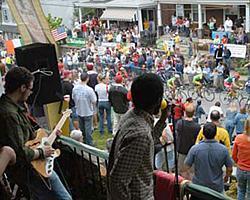
|
When it comes to cycling, I'll readily admit to being something of a snob, and the idea that a country where the SUV (Sports Utility Vehicle for the uninitiated) is king of the road, the concept of "American cycling" has always struck me as an oxymoron.
Yet with Lance Armstrong gunning for a unique sixth win in the Tour de France, the world's attention is on American cycling. Lance of course is just one of a bunch of great cyclists that have emerged from the American racing scene and beaten the Euro's at their own game. So what is the real deal on cycling in the USA?
I had followed the action from the Tour of Georgia back in April, and was impressed by the reports coming back from colleagues at the race. Of course, Lance Armstrong won with cool understatement, the race being effectively his home tour. My interest was piqued particularly by Gord Fraser's win over Super Mario Cipollini. Gord and I have shared more than a few beers and had oft suggested I make the trip Stateside; I was sorry not to see this feat.
Now was the time to go, and on advice I decided on a trip to Philadelphia for the Wachovia US Pro Championships, where Gord would be racing.
Where Gord goes, I go
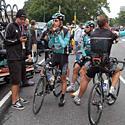
|
Held every June and now in its 20th year, the Wachovia USPRO Championship is the longest running and richest single day cycling race in the U.S. with a $130,000 purse. It's also one of the richest single-day events in the world for men. (OK, I'm impressed by big numbers!)
As distinct from the US National Champs in June, which is an all American affair, the USPRO pits the best of Americans against top riders from around the world. The top-placed US rider gets to wear the coveted Stars and Stripes as USPRO Champion for the coming year. If you're going to see one day of US road racing, I figured this is the one.
Still, I admit that it was with European bias that I approached this, my first US professional bike race, with a certain amount of scepticism. How, when no stick, no ball, no half-time show, would be visible, could the Americans possibly understand it, let alone shut down a fair amount of real-estate tarmac for a day?
Of course, I hoped I was wrong, and that the organisers of the Wachovia would manage to create a professionally slick event, showcasing world-class cycling, but with the open, friendly atmosphere American sports events are famed for.
The night before

|
I arrived in Philadelphia (which you soon call Philly just to save time) the day before the race. In the evening I strolled over to see Gord and the Health Net team at their hotel just a freewheeling distance from the start. It was drizzling gently, but I was amazed to see a crowd of a couple of hundred gathered at the start/finish line. Surely they couldn't be here to watch gantries being erected. Parked behind them were some dozen police vehicles, so I thought something serious was up. As I got closer I realised that everyone was watching one of the giant TV screens which would broadcast the race the next day.
Were they watching re-runs of previous races perhaps? Nope. The crowd had gathered for a Philadelphian passion - horse-racing. In this case, live coverage of the Belmont Stakes in which local steed Smarty Jones was attempting to be the first horse in to take the Triple Crown in 26 years. By all accounts, every TV in every bar in Philly was tuned to the event - some dreaming that would be for a bike race in the US.
Race day: Basking in bike racing
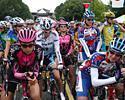
|
The next day at least dawned dry - though Philadelphia's horse-racing fraternity would not be in the mood to be pleased - Smarty Pants having been beaten in the last furlong by Birdstone the night before. The Wachovia has a remarkable record of 20 consecutive years without rain, and despite an overcast sky, the record was set to continue.
I was relieved to be able to reach the start easily thanks to Philly's wide roads. In Europe, it's often a matter of negotiating a network of medieval streets searching for the start line, arriving with barely enough time to draw breath, let alone conduct and interview. There is also the small matter of language. It is bad enough negotiating the traffic of a strange city without battling officialdom in a foreign language - simple questions like, 'Can I park there?', 'Can I stand here?' don't end up needing a translator. The answer might still be 'No!', but hey, at least you have a better chance of negotiating - and being English, I can still claim to be foreign!
It maybe the gleaming towers of Philly's Financial District in the background, but at the start the atmosphere was every bit like a big international bike race anywhere. While Frankie Andreu provided commentary, a cavalcade of sponsors vehicles toured the start-finish circuit.
The course comprises a 14.4 mile circuit, on which 140 of the world's best professional cyclists compete through Central Philadelphia on the fast and flat Benjamin Franklin Parkway and scenic Kelly Drive.
Including a few mini-laps in the finish area, the riders had to cover 156 miles - no mean feat in itself, except in the middle of each lap was the infamous Manayunk Wall.
The Manaya-what?
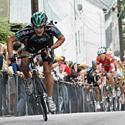
|
The Manaya-what? Everyone was talking about this 'Wall', and it was occupying a significant amount of time during team pep-talks. It turns out it is a 17 percent beast of a climb at the midway point of each lap that would strain the peloton to breaking point, and over the 10 laps, push the physical and mental limits of every rider. The 'Wall' then seemed the place to be then.
Manayunk (pronounced Man-e-yunk) is a suburb some 10 miles from downtown Philadelphia. For those with a keen sense of irony, the area was first called Flat Rock - try telling that to one of the riders struggling up the Wall! Supposedly, there was a piece of flat rock in the river. Flat Rock obviously didn't ring the charming note that the original town fathers had desired, so in 1824, the name was changed to Manayunk, derived from the Lenape Indian word "manaiung", meaning 'where we go to drink'. However, I doubt when they chose the name, they could have imagined just how far their 21st century descendents would take the word quite so literally!
In contrast to the quiet leafy riverside boulevards which comprise most of the course, the section in Manayunk was a heaving mass of humanity. Music blared out from several establishments, and a crush of people created a continuous current of movement alongside the race route.
No place for a dodgy car... but a perfect place to party!

|
For 364 days of the year, the Manayunk Wall, a.k.a. Lyceum Avenue, rests in anonymity, an ordinary looking street but for one thing - its precipitous gradient. This is not a place to park a car with a dodgy handbrake. It's not a particularly long climb, perhaps a mile or so in length, but it is steep - averaging something like 17 percent - and with each passing lap, it just gets harder and harder until the mere thought of having to do it again begins to prey on the mind. Let's face it: whether you are Bobby Julich or a lowly domestique from a third division team, the Manayunk Wall is never going to be easy. More like shades of acute discomfort.
What really marks the Wall apart from any other steep hill in any other race is the spectators. The Wall is smack in the middle of a neighbourhood of young families and students who take the race to heart and transform their section of the course into a vertical day-long street party.
There is hardly a house which isn't having a party - with a constant stream of people handing bikes and babies up steep stairs to get the best vantage points looking down the street. At 327 Lyceum, a sales rep from the local Brewery Yuenglings - America's oldest brewery founded 1829 - is hosting a party for friends complete with a Reggae band.
Swapping baguettes for hot dogs is one thing, but what is amazing is that in a city where American football, baseball and ice hockey hold sway, a bike race can be received with enough passion to make the scenes on Alpe d'Huez look positively tame!
There are of course true cycling fans aplenty here, who come from all over the US to witness what is indeed a spectacular race, but they are more than matched by a raucous crowd of 'fans for a day' - many of them young locals. Some of the guys had never seen a bike race - excluding a few seconds of Lance winning the Tour on ABC. Without exception, they had developed a rapid respect for the guys on bikes, especially if they had just struggled up the hill on foot.
With each passing lap, the crowds have grown huge and vocal. If the riders dread the climb, the spectators love it with a passion. It offers the perfect vantage point as the race effectively goes into slo-mo. As riders grind by, the spectators can enjoy a long lingering view of every grimace and gasp. The decibel levels reaches deafening as the riders are cheered on. Young women scream encouragement at their heroes - "Trent", "Bobby", "FREDDY!!!"
The Water Hole
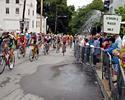
|
A major milestone on the Wall is O'Brien's Water Hole - a race institution. Located at 320 Lyceum, the 'Hole' is where Bill O'Brien, a resident for 43 years, has been hosting his friends and hosing down cyclists every June since the race began. The first year O'Brien did the hosing by hand, but could hardly pick up a pin the next day his arms were so tired. The following year, he came up with outdoor misty shower that the cyclists ride under to beat the heat. That happens at the same time that "the people come out in the yard and watch [the cyclists] go through the Water Hole," O'Brien said. "It's a good crowd of people. No rowdies. No smart stuff. They drink their beer there, then come back inside and get more. Back and forth. It's a nice day for everybody."
The Water Hole had few takers this year with low temperatures sparing riders the enervating effects of heat exhaustion. In past years, riders would have crowded each other dangerously close to go though the cooling spray. And it's not been unknown for riders to snatch a beer offered by someone from the crowd.
Back to the race...

|
The race itself was decided seven miles away back in downtown Philly, with Spain's Francisco Ventoso (Prodir Saunier Duval) beating Antonio Bucciero (Saeco) and Gord Fraser (Health Net) into second and third places respectively. Freddy Rodriguez in fourth place was named USPRO Champion.
Back in Manayunk, the party was still in full-swing and would be for at least a few more hours until the barriers were removed and the cars started returning. At that point, the Wall would begin its wait for another year to return to the limelight.
Certainly, from a competition point of view, the event was a brilliant introduction to US road-racing. My only concern was that witnessing this version from the City of Brotherly Love makes it hard to imagine anything else coming close for hospitality - not just in the US, but anywhere. Still, there's always next year to look forward to if I can't find one that does.
Wachovia USPRO Championships results
Cyclingnews travelled to the Wachovia US Pro with Virgin Atlantic Airways (www.virgin-atlantic.com). Travel arranged by Flight Centre UK (www.flightcentre.co.uk).
Photography
Images by Mark Sharon/marquev@clara.net
- Petra Rossner (Nürnberger Versicherung) and Regina Schleicher (Safi-Pasta Zara Manhattan) share a laugh at the start.
- Regina Schleicher (Safi-Pasta Zara Manhattan) at the start.
- Liberty Classic riders await the start.
- The Liberty Classic gets underway.
- Liberty Classic riders at speed.
- Liberty Classic riders on the Manayunk Wall.
- Liberty Classic riders tackle the Manayunk Wall.
- Susan Palmer-Komar (Genesis Scuba FFCC) tackles the Manayunk Wall.
- Freddy Rodriguez (Acqua e Sapone) at the start.
- Bobby Julich (CSC) and Chris Horner (Webcor) at the start.
- A Trent Klasna fan.
- Health Net pre-race.
- Henk Vogels (Navigators) at the start.
- Bobby Julich (CSC) at the start.
- Chris Horner (Webcor) at the start.
- Chris Horner (Webcor) climbs the Manayunk Wall.
- Cool weather sees riders avoid O'Brien's Water Hole.
- Freddy Rodriguez (Acqua e Sapone) on the Manayunk Wall.
- Grinding it out on the Manayunk Wall.
- A Health Net rider attacks the Manayunk Wall.
- The Reggae band serenades the riders as they climb the Manayunk Wall.
- Riders suffer on the Manayunk Wall.
- Riders tackle the Manayunk Wall.
- Some spectators watch the race on the Jumbotron. Some don't.
- Francisco Ventoso (Saunier Duval-Prodir) celebrates victory.
- Francisco Ventoso salutes the crowd.
- Francisco Ventoso enjoys the moment.
- The women's podium - (L to R) Gina Grain (Victory Brewing, 2nd), Petra Rossner (Nürnberger Versicherung, 1st), and Laura Van Gilder (Genesis Scuba FFCC).
- Women's winner Petra Rossner (Nürnberger Versicherung) enjoys the limelight.
- Men's winner Francisco Ventoso post-race.
- The men's podium - (L to R) Antonio Bucciero (Saeco, 2nd), Francisco Ventoso (Saunier-Duval, 1st) and Gord Fraser (Health Net/Maxxis, 3rd).
- Jelly Belly rider Doug Ollerenshaw on podium for the best climber award.
- US Champion Fred Rodriguez (Acqua e Sapone) holds his bike aloft.
- Freddy Rodriguez interviewed.
